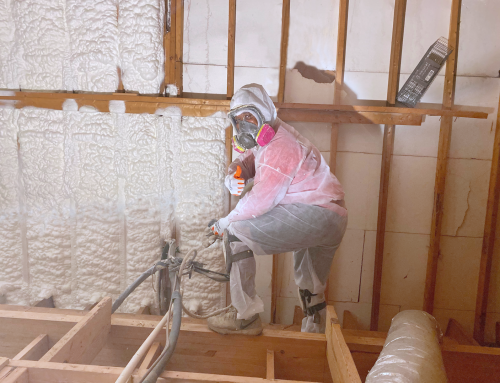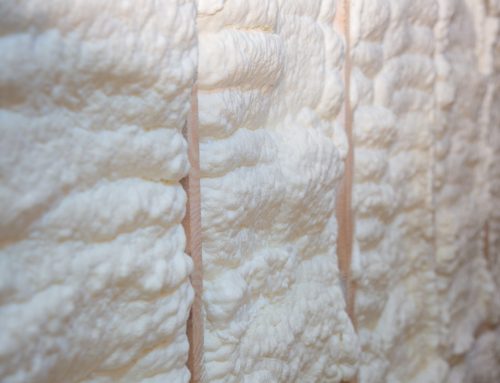8 Common Myths and Reality about Spray Foam Insulation
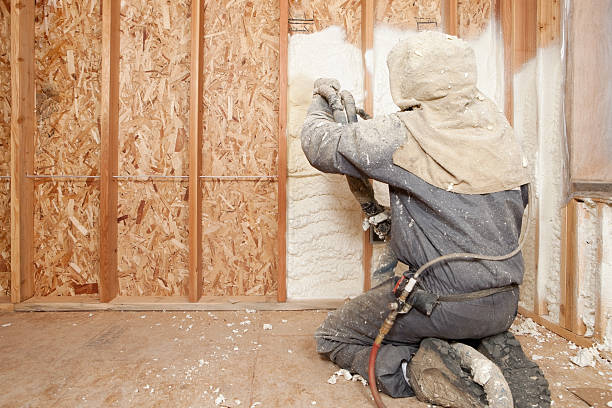
Spray foam insulation’s popularity has absolutely skyrocketed in recent years due to its energy efficiency and ease of DIY application. However, there are somehow still myths out there that continue to be perpetuated. While downsides to spray foam do exist, it is undeniable the best option for homeowners. A lot of things said about spray foam are factually incorrect, short-sighted, or downright absurd. Today we are going to be debunking 8 myths about spray foam insulation to help you make an informed decision about your home.
Myth #1: Spray Foam Insulation is Harmful to Your Health
Reality: While it is true that improper installation of spray foam insulation can release toxic fumes, DIY work never comes without its hazards. Whenever engaging in DIY work, make sure to study up on the precautions and have all your gear equipped. In this case, we’re talking about your spray foam insulation kits, protective gear (gloves, goggles, respirator), and whatever tools you plan to use, such as a utility knife and caulking gun).
Once spray foam insulation has cured, it is completely inert and poses no health risks to the occupants of the building. It’s also important to note that modern spray foam insulation products are formulated to meet stringent safety standards and regulations.
The hazards of other materials are much more substantial.
For instance, fiberglass Insulation causes skin and respiratory irritation due to the small glass fibers it is made of. Inhaling fiberglass particles can irritate the respiratory system, leading to:
- Coughing;
- sore throat;
- difficulty breathing.
The same issues apply to mineral wool insulation.
Cellulose Insulation, meanwhile, is made from recycled paper or other plant-based materials and can produce dust when handled or disturbed. Inhaling cellulose dust can irritate the respiratory system as well and aggravate existing conditions such as allergies or asthma.
Myth #2: Spray Foam Insulation Causes Mold Growth
Reality: nothing could be further from the truth. On the contrary, spray foam insulation is well-known for creating an airtight seal, which can help prevent moisture from entering the building.
Cellulose insulation, by contrast, is particularly bad for mold growth. Cellulose insulation is made from organic materials such as paper or cardboard that, when exposed to moisture or high humidity levels, can provide a conducive environment for mold to thrive. For fiberglass and rockwool, are also susceptible to mold developing if they stay damp for a prolonged period of time.
Myth #3: Spray Foam Insulation is Expensive

Reality: While it is true that spray foam insulation, being a superior-quality insulant, has a higher price tag compared to traditional insulation materials, such as fiberglass or cellulose, it still offers savings both in the short term and the long term.
Spray foam provides significant long-term savings through 50% lower energy bills. That’s dozens of dollars of savings every single month. Its R-value is the biggest reason why. Here is how its noise and heating insulation value compares to competing materials:
- Rock wool: ranges from 3.0 to 4.0;
- Fiberglass: 2.2-3.8;
- Cellulose: 3.1-3.8;
- Spray foam: R-6 to R-7 per inch.
Further lowering the upfront cost is that spray foam doesn’t even require full cavity depth. Especially if stud is thicker, you may only need four inches. Just sure that thickness is uniform.
On top of that, spray foam is a wise investment into your home in the long term, rendering it more durable and raising its market value. Fiberglass, cellulose, and rock wool cannot be counted on for the long term, as they are only good for between 10 and 30 year and after a while you will have to be insulating your home all over again. Spray foam meanwhile doubles that – lasting upwards of 50 years with proper care.
Myth #4: Spray Foam is Prone to Air Leakage Due to Shrinking, Crack, or Settling
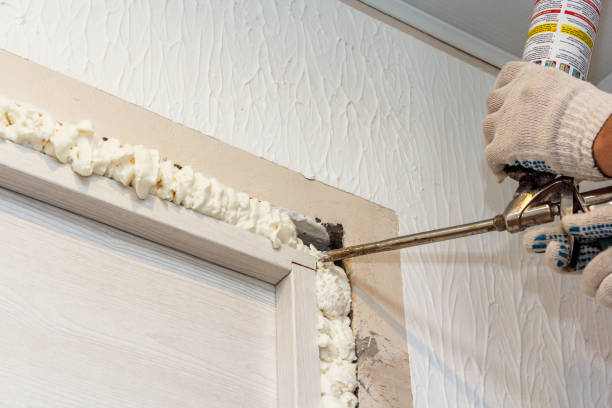
Reality: This is false. Spray foam expands and adheres to the surfaces it is sprayed on, creating a strong bond that eliminates the possibility of gaps or voids that can occur with other insulation materials. This adhesive quality contributes to airtight construction and reduces the risk of air infiltration.
It can also be quickly and effortlessly applied in the event that the homeowner or a professional neglected to cover certain areas, a problem that is particularly common with traditional materials as there are many spots which they simply cannot reach or expand to cover. Spray foam is the antidote to that, boasting the capability to assume any shape as well as self-seal around protrusions, electrical penetrations, and other potential air leakage points.
Properly installed spray foam insulation can maintain its air sealing properties over the long term without settling or deteriorating. This durability ensures that the airtight barrier remains intact for years.
Myth #5: Spray Foam’s Air-Tightness Impedes Ventilation
Reality: while it is true that an overly airtight building envelope can potentially trap indoor pollutants, leading to poor air quality, this can be mitigated through the implementation of a balanced ventilation system. Mechanical ventilation, such as HRV (Heat Recovery Ventilation) or ERV (Energy Recovery Ventilation) systems can help maintain a healthy indoor environment by continuously exchanging stale indoor air with fresh outdoor air while recovering heat or energy in the process.
Furthermore, a well-designed building envelope coupling air sealing measures with proper insulation can actually improve indoor air quality by reducing the infiltration of outdoor pollutants, allergens, and contaminants. By preventing drafts and air leakage, spray foam insulation can help create a more comfortable and healthier living environment for a home’s residents.
Myth 6: Spray Foam Causes a Foul Odor
Reality: this is partially true. This problem does occasionally occur due to certain technical hiccups. The good news is that even if this problem is encountered, it is still fixable.
Here are the main reasons why:
The foam chemicals weren’t mixed the right way: foam is delivered in the form of separate chemicals which then combine and then come out as one spray. It’s important to keep the proper balance of these chemicals to ensure proper insulation. It’s when this mistake occurs that a foul stench may result.
Proper ventilation was not performed according to the instructions of the manufacturer: ventilation is required around the time leading up to the job’s performance, while the job is being done as well as for a period afterwards.
Myth 7: Spray Foam Insulation is Bad for the Environment
Reality: though it is true that spray foam insulation is made from chemicals that contain greenhouse gases, the upside for the environment pays off many times over. Its R value which more than doubles all other materials on the market is a highly efficient insulating material that helps to reduce energy consumption and lower carbon emissions. This means less heat that has to be produced inside your home, energy savings by as much as 50%, and far fewer carbon emissions from within your home.
Myth 8: Spray Foam Insulation is Difficult to Install
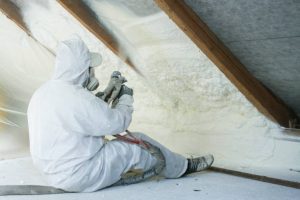
Reality: Let’s admit it. We can’t always afford to have a professional do everything, even if they may be more qualified. Plus, with a little practice, there’s little that a homeowner can’t do in his home on his on. By opting for a DIY approach, homeowners can save money on labor costs and potentially reduce their energy bills in the long run by improving their home’s energy efficiency.
Here are a few reasons why the average Joe can and should get started at using DIY spray foam insulation:
- Abundance of instructions and precautionary guides: in the information age, DIY information is widely available. Sray foam insulation has been made easier than ever to apply, especially with all the important instructions available. Just make sure to always wear the safety gear and prepare well according to the manufacturer’s instructions before you begin the job;
- Control over the project: DIY spray foam insulation allows homeowners to have full control over the project, from planning and preparation to application. DIY spray foam insulation kits are typically versatile and can be used in various areas of the home, such as attics, crawl spaces, walls, and basements as well as for specific insulation needs within the home. Plus, mistakes happen. Gaffes that took place during insulation’s installation can quickly be revisited and addressed afterwards;
- A learning opportunity: Engaging in a DIY project like spray foam insulation provides an opportunity for homeowners to learn new skills and gain practical knowledge about home improvement and energy efficiency. This hands-on approach can provide a sense of satisfaction and accomplishment for the average Joe looking to improve their home;
Conclusion
It’s undeniable that spray foam is the hot trend for insulation and its popularity is well justified. It’s best not to listen to what the competitors or ill-informed may say about it. Now you know the truth about these myths and have some good tips to get started insulating your home. Good luck in your DIY home endeavors.


